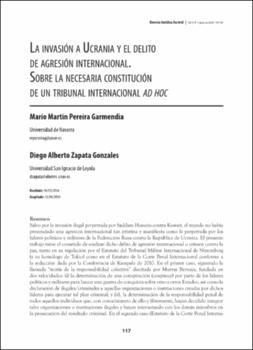| dc.contributor.author | Pereira Garmendia, Mario Martin | |
| dc.contributor.author | Zapata Gonzales, Diego Alberto | |
| dc.date.accessioned | 2024-07-10T15:07:09Z | |
| dc.date.available | 2024-07-10T15:07:09Z | |
| dc.date.issued | 2024-06 | |
| dc.identifier.citation | Pereira Garmendia, M. M., & Zapata Gonzales, D. A. (2024). La invasión a Ucrania y el delito de agresión internacional : Sobre la necesaria constitución de un tribunal internacional ad hoc . Revista Jurídica Austral, 5(1), 117-165. https://doi.org/10.26422/RJA.2024.0501.per | es |
| dc.identifier.issn | 2684-057X | |
| dc.identifier.uri | https://riu.austral.edu.ar/handle/123456789/3217 | |
| dc.description.abstract | Salvo por la invasión ilegal perpetrada por Saddam Hussein contra Kuwait, el mundo no había
presenciado una agresión internacional tan prístina y manifiesta como la perpetrada por los
líderes políticos y militares de la Federación Rusa contra la República de Ucrania. El presente
trabajo tiene el cometido de analizar dicho delito de agresión internacional o crimen contra la
paz, tanto en su regulación por el Estatuto del Tribunal Militar Internacional de Núremberg
(y su homólogo de Tokio) como en el Estatuto de la Corte Penal Internacional conforme a
la redacción dada por la Conferencia de Kampala de 2010. En el primer caso, siguiendo la
llamada “teoría de la responsabilidad colectiva” diseñada por Murray Bernays, fundada en
dos velocidades: (i) la determinación de una conspiración (conspiracy) por parte de los líderes
políticos y militares para lanzar una guerra de conquista sobre otro u otros Estados, así como la
declaración de ilegales/criminales a aquellas organizaciones o instituciones creadas por dichos
líderes para ejecutar tal plan criminal; y (ii), la determinación de la responsabilidad penal de
todos aquellos individuos que, con conocimiento de ello y libremente, hayan decidido integrar
tales organizaciones o instituciones ilegales y hayan interactuado con los demás miembros en
la prosecución del resultado criminal. En el segundo caso (Estatuto de la Corte Penal Internacional), el delito se ha tipificado como un tipo penal especial propio, respecto del cual no se
habilita a imputar responsabilidad alguna a título de partícipe sobre los extranei.
Asimismo, se argumentará sobre la necesidad de constituir un tribunal internacional penal ad
hoc o híbrido mediante un tratado bilateral celebrado entre Ucrania y la Asamblea General de
la ONU, cuya misión sea el juzgamiento y castigo de todos los responsables por el delito de
agresión internacional perpetrado contra el pueblo ucraniano. Este tribunal debería ostentar
competencia sólo sobre el delito de agresión internacional, así como habilitar el enjuiciamiento
in abstentia. | es |
| dc.description.abstract | Except for the illegal invasion perpetrated by Saddam Hussein against Kuwait, the world had
not witnessed such pristine and overt international aggression as that perpetrated by the political
and military leaders of the Russian Federation against the Republic of Ukraine. This article
analyzes the crime of international aggression or crime against peace, both in its regulation
by the Statute of the International Military Tribunal of Nuremberg (and its counterpart in
Tokyo) and in the Statute of the International Criminal Court in accordance with the wording
given by the Kampala Conference of 2010. The first case fits the so-called Theory of Collective
Responsibility designed by Murray Bernays, founded on two speeds: (i) the determination of a
conspiracy by the political and military leaders to launch a war of conquest over another State
or States, as well as the outlawing of those organizations or institutions created by the leaders
to execute the criminal plan; and (ii) the determination of the criminal responsibility of all
those individuals who, knowingly and freely, have decided to join such illegal organizations or
institutions and have interacted with the other members in the pursuit of the criminal result.
In the second case (Statute of the International Criminal Court), the crime has been classified
as its particular criminal type, concerning which there is no possibility of attributing liability
to third parties.
Likewise, the need to establish an ad hoc or hybrid international criminal tribunal through a
bilateral treaty between Ukraine and the UN General Assembly is advocated. The mission of
such a tribunal should be to prosecute and punish all those responsible for the crime of international
aggression perpetrated against the Ukrainian people. Such a tribunal should have
jurisdiction only over the crime of international aggression, with the possibility of conducting
trials in absentia. | es |
| dc.language.iso | es | es |
| dc.publisher | Universidad Austral. Facultad de Derecho | es |
| dc.relation.ispartofseries | Vol. 5, no. 1, 2024; | |
| dc.rights.uri | http://creativecommons.org/licenses/by-nc-nd/4.0/ | * |
| dc.subject | Delitos atroces | es |
| dc.subject | Guerra de agresión | es |
| dc.subject | Agresión internacional | es |
| dc.subject | Competencia Corte Penal Internacional | es |
| dc.subject | Conspirancy | es |
| dc.subject | Membership | es |
| dc.subject | Juicio en ausencia | es |
| dc.subject | Heinous crimes | es |
| dc.subject | Aggression war | es |
| dc.subject | International aggression | es |
| dc.subject | International Criminal Court jurisdiction | es |
| dc.subject | Trials in absentia | es |
| dc.title | La invasión a Ucrania y el delito de agresión internacional : sobre la necesaria constitución de un tribunal internacional ad hoc | es |
| dc.title.alternative | The Invasion of Ukraine and the Crime of International Aggression: On the Need to Create an Ad Hoc International Tribunal | es |
| dc.type | Article | es |
| dc.rights.license | Attribution-NonCommercial-NoDerivatives 4.0 Internacional | * |



